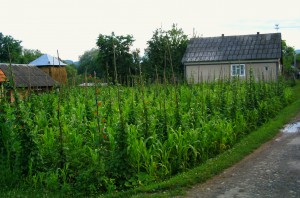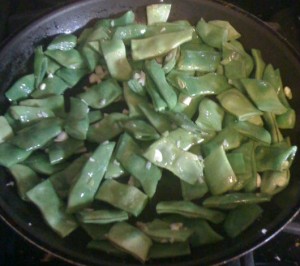Beans have considerable significance in the cuisine of Zakarpattia. One of my favorite dishes is terta fasol’ (mashed beans), made from dried kidney beans boiled and smashed with oil and large amounts of fresh chopped garlic , served as a spread with fresh bread. The dish seems faintly out of place, more akin to Georgian lobio or Egyptian foul than a homey Slavic meal. Dried beans are also used in soups and a few other dishes but it is pole beans that are a real staple throughout the region. Nutritious and fast-growing, pole beans, called lopatky in Zakarpattia, figure large in summer fare. Equally important, from a cultural standpoint, is the techka, or bean pole, which serves many purposes, from bean pole to kindling to improvised weapon. Most notably, the bean pole is the equivalent of the American rolling pin as a symbol of domestic discord. To say that one has seen a neighbor chasing his or her spouse wielding a techka is to state unequivocally that there is trouble in paradise. Made from strong, straight sticks about 2 inches in diameter and 7 feet tall, techky are kept from year to year, and establish order in the neat garden plots that adjoin many a house in the region.
In the photograph included with this post you can see many features of the Zakarpattia landscape – a stucco house with a garden right outside; a large square hayrack nearby, and row upon row of lopatky marking the family garden, where potatoes, feed corn, squash and beets are all grown. Here the lopatky are just flowering, but as soon as the pods begin to ripen, they are brought directly to the table. One of the most important dishes prepared from lopatky is “serbanka,” a soup made from sour milk, paprika, porkfat, new potatoes, and pole beans. Indeed, the soup has its own verb serbaty, which is colloquially used as a general term to mean “to eat soup” or “have a light meal.” Serbanka is somewhat of an acquired taste – you learn to love the flavor of the sour milk as a savory base or you don’t. Lopatky are also served as a main dish – boiled and then sauteed with oil and garlic. Cooked new potatoes can be added to the mix to beef up the dish, which is also served with bread. Lopatky can be prepared with lard or vegetable oil, and are a favorite choice for a main dish during Orthodox Christian fasts, when believers do not consume dairy or animal products aside from fish. I can not imagine the Zakarpattia landscape – cultural or physical, without rows of leafy green columns wrapped around bean poles, or a Zakarpattia table without a plate or two of lopatky at the end of a summer’s day.
Serbanka
10-15 pole beans, strings removed and cut in thirds
10 small new potatoes or 2 large potatoes, cut into 1-inch pieces and boiled
1/4 cup onion, chopped
1.5 tbsp lard, bacon grease or vegetable oil
1 cup buttermilk, or 1/4 cup sour cream (for a fat free option, try fat free Greek yogurt)
1/2 tsp sweet paprika
1/2 tsp. salt
Heat oil in a large saucepan. Add boiled potato and onion. Saute over medium heat until onion is slightly browned. Add pole beans and cook, stirring, for one minute. Add paprika, salt and 2-3 cups water. Bring to a boil, then lower heat and simmer until beans are tender, about 20 minutes. Add buttermilk and cook 15 minutes more. Adjust salt to taste. Serve with fresh bread.
Lopatky (Pole Beans Zakarpattia Style)
1 lb. pole beans such as Roma, strings removed and cut into 2-inch pieces
3-4 large cloves garlic peeled and finely chopped
3 tbsp. olive oil
salt and pepper to taste
Boil the beans for 15 minutes or until just tender. Drain. Heat oil in large skillet. Add garlic and saute 1 minute. Add pole beans and salt. Cook, stirring for 5 minutes more. Adjust salt and pepper to taste. Serve with starch of choice (potatoes, pasta, rice, bread).
Tags: pole beans





Recent Comments